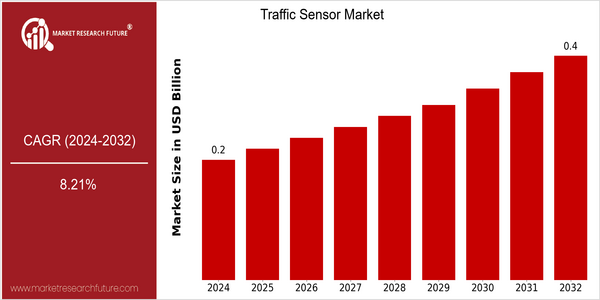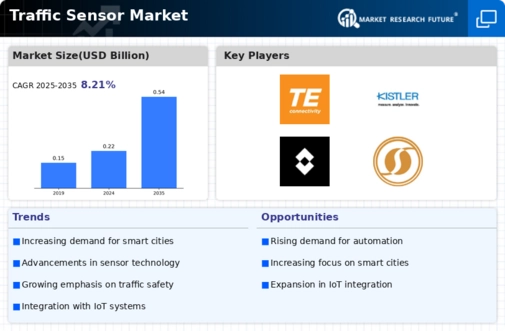Traffic Sensor Size
Market Size Snapshot
| Year | Value |
|---|---|
| 2024 | USD 0.22 Billion |
| 2032 | USD 0.43 Billion |
| CAGR (2024-2032) | 8.21 % |
Note – Market size depicts the revenue generated over the financial year
The world traffic sensors market is estimated to be worth $ .2 billion in 2024, and is projected to reach $ .4 billion by 2032, growing at a CAGR of a robust 8.21% during the forecast period. This growth trajectory is a result of a rise in demand for smart traffic management solutions, which is a result of increasing urbanization, the need for an efficient transportation system, and the increasing adoption of smart city initiatives. The advancement of technology, such as the IoT-enabled devices, has also contributed to the growth of the market. Artificial intelligence and machine learning have been integrated into the traffic management systems, which is expected to improve traffic flow and congestion. Various players, such as Siemens, Kistler, and FLIR, are investing in R&D, entering into strategic alliances, and launching new products to capitalize on these trends. Various collaborations between these players, such as the one between GE Transportation and Cubic, are a clear indication of the industry’s commitment to deploying smart mobility solutions.

Regional Market Size
Regional Deep Dive
The traffic sensors market is experiencing a significant growth in the coming years, owing to the increasing urbanization, the need for smart city projects, and advancements in the sensor technology. The market is characterized by unique characteristics, which are influenced by the regional regulations, the state of the local road network, and the rate of technology adoption. In North America, the focus is on the integration of traffic sensors with intelligent transportation systems, while Europe focuses on the implementation of sustainable and environment-friendly policies. The Asia-Pacific region is rapidly adopting traffic sensors due to the increasing population and urbanization, while the Middle East and Africa are investing in smart infrastructure to enhance the traffic management. Latin America is also experiencing growth in the traffic sensors market, as it is a result of the modernization of the road network to reduce congestion and improve road safety.
Europe
- The European Union's Green Deal is pushing for the adoption of smart traffic management systems, including traffic sensors, to reduce emissions and improve air quality in urban centers.
- Innovations in sensor technology, such as the deployment of AI-driven analytics by companies like Bosch, are transforming how traffic data is collected and utilized, leading to more efficient traffic flow.
Asia Pacific
- China's rapid urbanization has led to significant investments in smart city projects, with traffic sensors being a critical component for managing the increasing vehicular population.
- Countries like Japan are leveraging advanced sensor technologies to enhance public transportation systems, aiming to reduce congestion and improve commuter experiences.
Latin America
- Brazil is implementing smart traffic management systems in major cities like São Paulo, utilizing traffic sensors to monitor and manage congestion effectively.
- Innovative partnerships between local governments and tech companies are emerging in Latin America, focusing on deploying traffic sensors to enhance urban mobility and safety.
North America
- The U.S. Department of Transportation has launched initiatives to promote the integration of traffic sensors with connected vehicle technology, enhancing real-time data collection and traffic management.
- Companies like Siemens and Kistler are leading the development of advanced traffic sensor technologies, focusing on improving accuracy and reducing costs, which is expected to drive wider adoption in urban areas.
Middle East And Africa
- The UAE is investing heavily in smart city initiatives, with projects like Dubai's Smart City Strategy incorporating traffic sensors to optimize traffic flow and reduce congestion.
- Governments in Africa are beginning to recognize the importance of traffic management systems, with countries like South Africa implementing pilot projects to test the effectiveness of traffic sensors in urban areas.
Did You Know?
“Traffic sensors can reduce congestion by up to 30% when integrated with intelligent transportation systems, significantly improving travel times and reducing emissions.” — Institute of Transportation Engineers
Segmental Market Size
The traffic sensors market is the most important segment in enhancing traffic management and safety. This market is currently undergoing steady growth due to the growing need for efficient traffic management and the growing population of cities. There is a strong demand for real-time traffic data in the smart cities. The policy to reduce congestion and emissions has also increased the demand for real-time traffic data. The technological development of sensors, such as the IoT and the artificial intelligence, will make this market even more important in the modernization of the city's urban structure. The current deployment of traffic sensors is at the scale deployment stage. The cities in Los Angeles and Singapore are the first to integrate advanced traffic monitoring systems. In the traffic sensors market, the main application is to monitor traffic flow, detect accidents, and optimize smart parking. The leading companies in this field are Siemens and Cisco. The trend of promoting sustainable urban mobility and the push for the development of driverless vehicles will drive the growth of this market. The application of machine learning and cloud computing will also promote the development of traffic sensors.
Future Outlook
The traffic sensors market is set to experience a CAGR of 8.21% from 2024 to 2032, growing from $230 million to $430 million, at a CAGR of 8.21%. This growth is largely due to the increasing demand for smart cities and the integration of advanced traffic management systems. As urbanization increases, cities are investing more in the integration of new traffic management systems to improve traffic flow, reduce congestion, and enhance safety. This is expected to lead to a higher rate of adoption for traffic sensors. By 2032, it is estimated that traffic sensors will be used in more than 60% of urban areas, as cities seek to optimize their transportation systems with data-driven insights. Further driving the market are the technological developments of the Internet of Things (IoT) and artificial intelligence (AI). These innovations will not only increase the accuracy and efficiency of traffic monitoring, but also allow for the real-time sharing of information between various stakeholders, such as city planners and transportation agencies. Furthermore, government initiatives to reduce carbon emissions and promote sustainable transportation will increase the demand for traffic sensors. Also, the integration of traffic sensors with driverless cars and the development of connected transportation systems will help shape the future of the market, allowing for the most advanced and responsive traffic management.








Leave a Comment